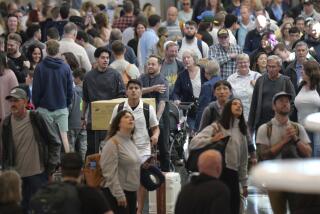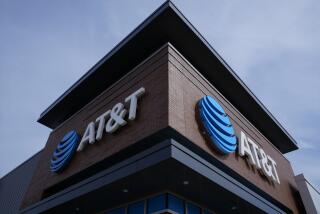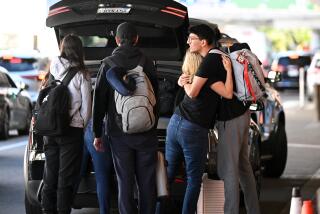Carriers See Tiny Uptick in Travelers
The nation’s top airlines reported Sunday only a slight pickup in passengers over the last few days, underscoring the struggle they face in persuading travelers to resume flying after the terrorist attacks.
The four biggest carriers--AMR Corp.’s American Airlines, UAL Corp.’s United Airlines, Delta Air Lines Inc. and Northwest Airlines Inc.--all said that they have filled more seats recently, but still far too few to operate profitably.
Several airline officials also said the increase in passengers has been so small that it’s not clear whether a genuine comeback has begun.
“Are these people coming back so far because they absolutely, positively have to travel? Or, as time passes, are they gaining more confidence in the airline industry? I don’t think we really know that for sure yet,” said John Hotard, a spokesman for American Airlines, the nation’s No. 1 air carrier.
Hotard said that in the last few days, American has flown only about one-third of the nearly 250,000 passengers it averaged daily before the Sept. 11 terrorist attacks. Still, he said, the percentage of filled seats on American’s planes crept up from 47% on Thursday, to 50% on Friday and 52% on Saturday. He said American had not yet compiled Sunday’s results.
At the same time, Dallas-based American is restoring more service every day and plans to continue until it reaches 2,000 daily flights, possibly by early this week. That new level of service is down from the pre-attacks level of 2,500 daily flights, reflecting the 20% to 25% retrenchments announced by carriers throughout the industry.
The slightly improving situation was apparent at other major carriers, too. When Northwest Airlines began flying its new daily package of 1,400 flights last Monday--down from the pre-attacks level of 1,700--passengers filled about 50% of the carrier’s seats. Over the weekend, the level appeared to be up to 54% or 55%, said Northwest spokesman Doug Killian.
“It’s ticking up very slowly,” Killian said. The passenger total “is still far below a profitable level, but it’s encouraging.”
The downturn in air travel began even before Sept. 11, largely as a result of a decline in business travel amid a cooling national economy. But the industry slump has been aggravated by the reluctance of consumers, after the terrorist attacks on New York and the Pentagon, to take pleasure trips.
Richard Feinberg, a consumer psychologist at Purdue University, said consumers have cooled on flying not so much because they are fearful of their plane being hijacked. Rather, he said, it’s mainly a shift in the mood of many consumers.
“They want to stay where they feel comfortable, so they’re staying home,” Feinberg said. “As with everything else, time heals. But with so much that is uncertain, things might not heal for a while.”
In the meantime, the airlines are losing more than $200 million a day. To try to head off bankruptcies, President Bush on Saturday signed a $15-billion rescue package for the industry that includes $5 billion in immediate cash and $10 billion in loan guarantees.
The major carriers have responded by announcing a succession of layoffs expected to eventually eliminate the jobs of more than 100,000 workers. That retrenchment, in turn, is rippling through related industries, such as hotels and restaurants, and is thought by many analysts to raise the likelihood of a national recession.
Bill Marriott Jr., chief executive of the hotel group Marriott International, said Sunday that the company’s business would be down 25% to 40% through the end of the year. In an interview on CNN’s “Late Edition,” Marriott said this month has been tough for the company, which operates 2,200 hotels worldwide, but that prospects for next month look better. In the meantime, the chain has shifted many full-time employees to part-time status to reduce costs until business recovers.
Reuters was used in compiling this report.
More to Read
Inside the business of entertainment
The Wide Shot brings you news, analysis and insights on everything from streaming wars to production — and what it all means for the future.
You may occasionally receive promotional content from the Los Angeles Times.










